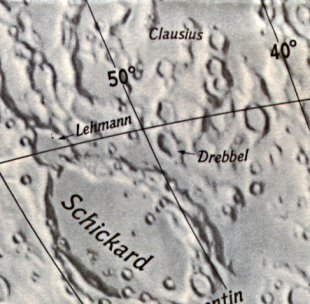

Date/Time: 2003/2/13, ~2:30 to 7:25 UT Location: ASH Naylor Observatory, 670 Observatory Drive, Lewisberry, PA, USA Instrument: 17" f/15 classical Cassegrain Magnifications: 162, 202, 216, 259, 381, 404, and 432x Conditions: Clear to partly cloudy, windy, dome temperature - 20 degrees Fahrenheit, relative humidity - 56% Seeing: Variable
While observing the moon on Wednesday night, 2003/2/12 at ~9:30 p.m. EST (20003/2/13 at ~2:30 UT), I happened to notice a possible lunar sunrise ray in an area west of the crater Clausius in Lacus Excellentiae. The ray, located at approximately 46 degrees W and 37 degrees S, was a moderately narrow triangle when I first saw it. By the time I last looked at the moon at ~2:25 a.m. EST (~7:25 UT) the ray had broadened to the point that it was no longer recognizable as such.Dave Mitsky
Using the coordinates of the ASH Naylor Observatory, and the times given, we have:
Site Longitude = +76.880 Site Latitude = +40.150 Feature = Near Clausius Feature Longitude: = -46.000 Feature Latitude: = -37.000 Reproducing Lighting For: 2003/2/13 at 02:30 U.T. Desired Solar Altitude = +1.859(Rising), Azimuth = +90.480 Average Co-longitude = 48.328
Clausius, -555,-600: Although this crater is only 8 miles in diameter, it is conspicuous, and has a craterlet on the south crest with another on the northern. There is a small central hill on the interior. To the northwest is a heart-shaped crater, B, a striking object, with a crater on its north-west rim, and another on the inner north-east. To the northwest of B is a smaller crater, C, while on the west of B, beyond two craterlet chains, is the large ring, F, with three craterlets in a row on its interior. South of Clausius is crater D, which overlaps another to the south (Wilkins and Moore, The Moon, 1955, Faber & Faber Ltd)

